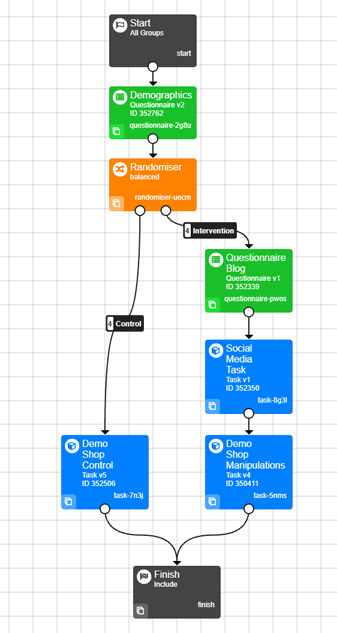This is a practical exercise for business and marketing students that allows you to experiment with different marketing techniques, and then test them in a real-world experiment. The Kings Business School class of 2021 made a video showcasing their experience:
If you are interested in running this course with your students, please contact us!
The Experiment
Your participants will take part in a simulated online shopping experience. They will be told to buy a single item for a specific person (e.g. a gift for a 21st birthday). The exact set of items in the shop, and the personality of the person that they are buying for, will be determined by your instructor (but you will be told what they are). We will recruit a number of real-world participants to take part in the shopping experience, and measure what they choose.
Your Task
Your task is to use a variety of marketing techniques to nudge people towards a particular product. For example, you can attach labels to differentiate it in some way, change how it is described, change its image in the shop itself, place adverts in the shop to promote it, and so on. Additionally, you can implement some marketing before your participants reach the shop. For example, you can present them with an invented blog article or social media feed in which your product is promoted in some way.
Your instructor will tell you the groups you will be working in and what your group will need to achieve, as well as details about:
You will also be given a timeline - the exact dates will be specific to your course, but include the following phases:

|
Once complete, your experiment will probably look something like this: As you can see, participants start at the top, they all complete a demographics form, and then are randomised to two conditions. Half of the participants will just do the shopping task in an unmodified version of the shop. We call this the 'Control' condition, because it gives us a baseline for what people do without any influence from us. The other half of the participants will be exposed to your various marketing elements (in this case a blog and a social media feed), before doing the shopping task in the enhanced version of the shop (which includes all your in-shop marketing elements). We call this the 'Intervention' condition, because it's the one where we're intervening. We can then compare the number of people who buy the target product in the Intervention condition to the number of people who choose it in the Control condition to get a measure of how effective our marketing has been. Your task is to create the Blog, Social Media task and the Intervention Shop. Your instructor will put you into teams to do this. |

|
Your instructor will provide you with the exact details of your assignment, so first make sure you are clear on the target product and consumer avatar.
The next step is to start thinking about the marketing elements that you want to test. Your instructor may assign you to separate teams, or for smaller groups have everyone in one team.
You will want to agree an overall marketing strategy with your team, and then we suggest dividing yourselves into groups, so that one group can focus on e.g. the blog, another on the social media content, and a third on the shop itself. Start by drawing or mocking up how you want things to look (you can do this in PowerPoint or just pen-and-paper), and then create the images and artwork that you need. Finally, you can use the Gorilla tools to add your content to the experiment.
Your instructor may also have arranged some dedicated support time with the Gorilla team to help you put everything together - make sure you've created all the artwork you need before this time so that we can help you finalise everything.
You can find the example tasks on this Gorilla Open Materials page: Influencing Consumers
Sign up to Gorilla using your institution's email address, if you don't already have an account. You'll be prompted to take part in the introductory tutorial - you can skip this for now. One person from each group will need to create a project which you can clone the course materials into. Within this project, you can edit the Tasks and Shops and start implementing your marketing strategy.
To get started with editing your shop, you need to make sure you have cloned the shop from the Open Materials page first.
You can find further documentation for Shop Builder here: Shop Builder Documentation
To get started with editing your blog, you need to make sure you have cloned the questionnaire from the Open Materials page first.
You can find further documentation for Questionnaire Builder here: Questionnaire Builder 2 Documentation
To get started with editing your social media task, you need to make sure you have cloned the task from the Open Materials page first.
You can find further documentation for Task Builder here: Task Builder 2 Documentation
Check out this video on how consumer psychology is used in industry from Gareth Harvey from BeOnline 2022